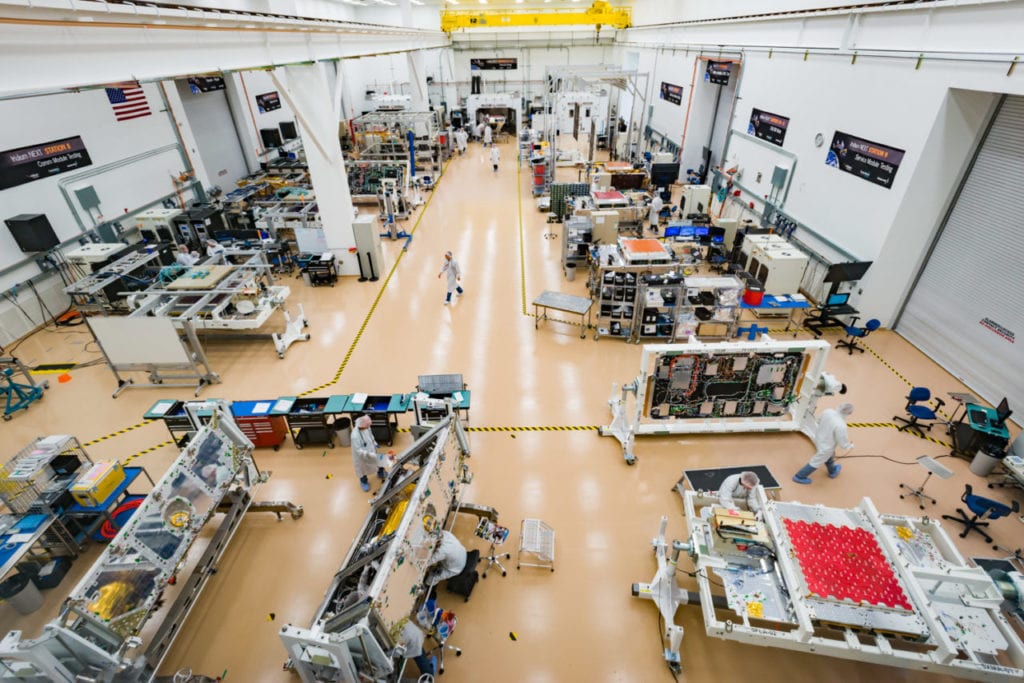Latest News

The Iridium Next production line at Orbital ATK’s satellite manufacturing facility in Gilbert, Arizona. Photo: Orbital ATK.
As fiscal year 2017 financials trickled in, it was clear that the impact of a changing market and pricing declines continues to hit the bottom line of commercial satellite operators. Operators are being forced to re-evaluate decisions on multiple levels; from which applications to target, partners to engage, and satellites to order. There are two main paths for satcom operators as they weigh future procurements: to reduce risk and optimize CAPEX, or to boost capabilities and competitiveness. The holy grail, of course, is to accomplish both.
Each path encompasses multiple and at times conflicting options. Reducing risk and optimizing CAPEX can include such approaches as multi-satellite contracts to secure attractive manufacturing prices or launching a smaller payload via condosats (such as Telesat/APT Satellite, Kacific/JSAT) or small satellites (Astranis) to increase fill rates and guarantee revenue generation. Operators across the globe are re-assessing optimal fleet age, attracted by advantages to both shorter — less risk on accurately forecasting market demand or having the right technologies to competitively address it — and longer — delay replacement costs while gaining additional time to vet new satellite design for the anticipated target market — lifetimes compared to today’s 15- to 18-year norm. And 50 percent of orders in the last two years opted for electric or hybrid propulsion for orbit raising, saving on launch costs in exchange for a delay in start of service.
If instead prioritizing an increase to capabilities and competitiveness, operators might look to next generation High Throughput Satellite (HTS) technologies, advanced ground segment, and/or Q/V-band or optical feeder links to increase service quality, broaden addressable markets, or tap into new applications. While demanding a higher upfront CAPEX, the low cost per bit with such solutions can be compelling in today’s price-sensitive market — a dynamic that has driven players like Viasat to invest in the very high capacity ViaSat 3 system and Eutelsat to launch an experimental Q/V-band payload. Opting for various elements of on-board flexibility can enable more efficient daily or lifetime utilization of satellite resources tailored to customer needs, particularly in the fast-growing mobility markets. SES’ recently launched SES-12 carries a digital transparent processor to deliver such customizable services.
Amid considerations on the design and framework of future GEO procurements is the role of non-GEO capacity in an operator’s fleet and competition. Some operators remain committed to a GEO-only paradigm (ABS, Inmarsat), while others are looking to balance investment across GEO and non-GEO orbits with either a proprietary constellation or a partnership with a non-GEO player (Telesat, JSAT). While non-GEO mega-constellations are very much a symptom rather than a cause of the current moment of satcom industry evolution, their development is in turn creating challenges and forcing a change in GEO practices.
In tomorrow’s increasingly complex market, which such strategies will prevail?
It will undoubtedly be a blend. Whereas the former dominant GEO satcom strategy was to launch a largely pre-sold generic payload with some additional capacity for growth using high heritage components and understood designs, the strategy set of tomorrow will be diverse. The satcom market itself has diversified, with multiple new and rapidly growing applications and target markets to address. Given this progress and its implications for distinctions in the type of demand each operator will target, coupled with each operator’s unique blend of terrestrial and on-orbit assets, slot access, and partnerships, it is inconceivable for operators to pursue similar strategies and find success. There is no longer a one-size-fits-all.
Ultimately this shifting environment will impact the manufacturers charged with constructing the busses and payloads operators choose to invest in. This means manufacturers will face a more complex demand landscape that requires ongoing Research and Development (R&D), closer collaboration with customers on design, and greater creativity in addressing the range of operator requirements. The pace of technical innovation from manufacturers must match the pace of end-user market evolution.
Despite the many changes unfolding in the industry, most operators have not yet identified a cohesive strategy. Some, such as SES and Inmarsat, have proposed new fleet-centric replacement plans, but as seen in the low order rates of recent years, the bulk of players continue to delay decision-making. As satellites age and the fight for market share in growing applications heats up, operators will need to commit to objectives and place bets on new assets. With a wide spectrum of options, opportunities, and challenges in front of them, operators will choose a more diverse set of satellite design and procurement strategies in the coming years.

Carolyn Belle is a senior analyst with NSR, focusing on satellite manufacturing, launch, and in-space activity, and in particular the trends surrounding creation of diversified space architectures.
Get the latest Via Satellite news!
Subscribe Now